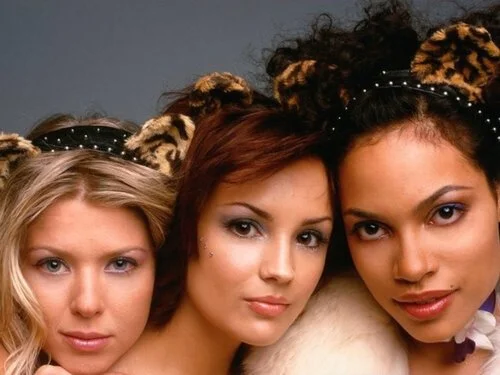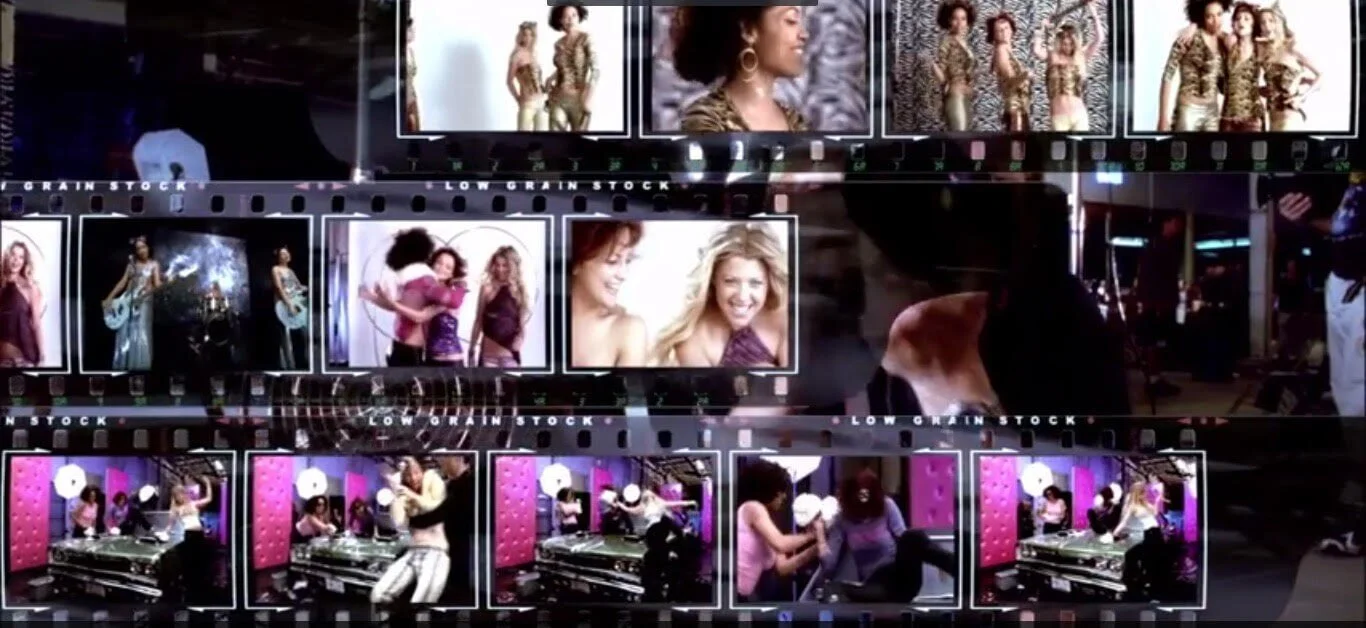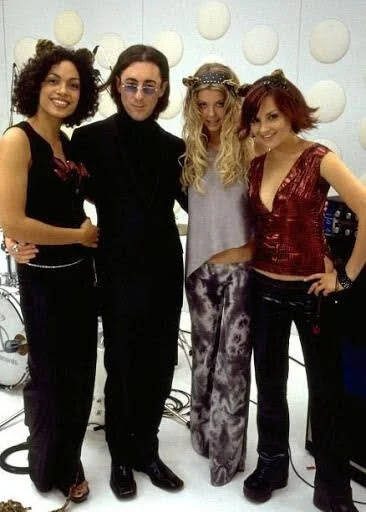Episode 3: production — “It Wasn’t Easy”: Looking Back On Josie And The Pussycats Production With The Directors And Stars
Rachael Leigh Cook, Tara Reid and Rosario Dawson bunker down in band camp in Los Angeles as they learn how to be rock stars, while the physical production heads to Canada writes Maria Lewis
With Deborah Kaplan and Harry Elfont locked in as writers and directors off the back of their debut hit Can’t Hardly Wait, they shifted their original pitch from Josie And The Pussycats In Outer Space like the Hanna-Barbera cartoon to something … else. They came up with an idea for something satirical, something witty, something current to take the Archie Comics spin-off characters into the present. “I think the first idea was oh, wouldn’t it be funny if we said all the music that seems so kind of bland and generic … everyone is loving that because they’re being brainwashed,” says Elfont. “And then we thought ‘okay, well, what if they’re selling things’ and the whole satire of consumerism, all of the pop culture and capitalism, came from that.” The pair showed early versions of their script to producers they trusted, many who didn’t get what they were intending to do. “To us, it seemed very clear,” says Kaplan. “Again, I guess having come out of college during grunge and suddenly seeing everything get sanitised and people in matching outfits, it felt weird. It felt like something nefarious was going on, even if it wasn’t. It felt like we were being fed something we didn’t want and people were dining out on it.”
Their Trojan Horse of a take goes into pre-production, with the trio of Josie and the Pussycats cemented as Rachael Leigh Cook as Josie, Tara Reid as Melody and Rosario Dawson as Valerie. With their crew assembled, the next step was band camp. And no, not the Disney movie version: this was sans Jonas Brothers. For Josie and the Pussycats to be believable on screen, they needed to be believable in real life. So the girls had to learn play their instruments, get to know each other, figure out their chemistry, and work out what their stage presence was as a band. “We all ran in very different circles,” says Cook. “Soon as we became comfortable with each other, we had this whole world that we needed to talk about and understand each other as well as we could … It was a very summer camp experience.”
All of the Pussycats were famous in their own right, but they did each come from very different backgrounds. Reid had exploded after a string of hits: The Big Lebowski, Urban Legend, Cruel Intentions and American Pie. Cook had been working for ages, starring in her first movie The Babysitter’s Club back in 1995 and she’d been backing up projects one after the other ever since: She’s All That, The Hairy Bird and Antitrust. She had a lot of experience and a lot of work. Dawson was more of an unknown entity. She’d been in a few films, but it was after Spike Lee’s He Got Game and King Of The Jungle that she became one to watch. “Rosario is one of those people the buzz is really on right now,” Cook said at the time in an interview on the set of Josie And The Pussycats. “Everyone wants to meet her or work with her or tell me how great she is and they’re all right.” They each brought something different to the project, but they weren’t the full package yet.
“Deb and Harry and probably mostly the studio were all justifiably concerned about my stage presence,” recalls Cook. “So they hired this band, Powder, who I had seen a video of before we knew we were going to be working with them. I remember the lead singer lighting a hula hoop on fire and swinging it over her head and I was thinking ‘what kind of movie is this?’ It was a lot of look. So we worked with them for a while. I don’t know how much of that I brought to the performance other than a general degree of concern … But then Kay came in, Kay Hanley. We’d all been learning to play the actual instruments so we weren’t fakers … We had our heads down and we learned those five chords backwards. We did our best. Then Kay came in and just sung her face off and brought that spirit and Deb and Harry were like yeah ‘you can kinda do that, we’re off to the races’ ... Deb and Harry were just hyper aware that we needed to do this right.” Hanley and Kaplan knew each other through the “Boston connection”: they’d both grown up there, Hanley just next door to Mark Wahlberg and his 82 brothers. While Kaplan had gotten into filmmaking, she’d stayed connected and interested and invested in the musical industry where Hanley was thriving as the frontwoman of Letters To Cleo. They were one of those staple indie bands of the nineties, with their covers of I Want You To Want Me and Cruel To Be Kind probably what most people will recognise as they appeared playing them in 10 Things I Hate About You (and on the soundtrack).
Hanley comes on board as the singing voice of Cook’s Josie and she’s part of this insaneo in the braino musical creative team that we’ll dive into more when talking specifically about the soundtrack. They’d tried a few different voices for Josie and in the filmmakers minds, none had fit in quite the same way Hanley did. “The pre-amble to that happening was everyone asked the question ‘can Rachael sing?’ I was like ‘well, I don’t know’,” says Cook, who was a big Letters To Cleo fan. “Because like a lot of people, anyone who has sung in their car or in the shower and thought ‘maybe I’m okay, maybe they can work some magic’. So I went into the studio with Deb and Harry, did my best version of I’m pretty sure a Blink 182 song – something I had no business singing – and it was terrible. But I remember everyone being generally very positive with me and Kenny (Edmonds) saying ‘you can carry a tune, you’re singing in this movie’ and I was like ‘I’m gonna be singing in the movie!’ I am not singing in the movie, whoops. It’s really for the best though.” Kaplan says they saw a lot of people for the singing part of Josie and that it “was hard to find her voice” before they synched with Hanley. “It was something about the match, it was the match of the voice to the picture,” says Elfont. “We’d had somebody record all the songs and it didn’t work … Even Kay’s voice, her Letters To Cleo voice is a little different. She had this rasp when she was singing for Josie that just worked better and I remember doing take after take and when she was a little worn out, that’s when it worked.”
That rasp wasn’t imagined: Hanley had just had a baby with her partner and fellow Letters To Cleo bandmember Michael Eisenstein. She knew her voice sounded different, she could hear it in the sound booth when she was recording those songs, and it ended up being perfect for what they needed. “They had hired this local LA band to teach Rosario, Tara and Rachael how to look authentic in a rock band and it was this band called Powder,” says Hanley. “They were (these) crazy, OTT, Sunset Strip metal heads with all these acrobatics. I mean they were amazing, but not at all what you would you would think Josie and the Pussycats would be doing. They (Josie) were a very reluctant rock star situation.” Hanley worked with the girls on a sound stage in Los Angeles, perfecting their music moves in a mirrored room until everyone felt like they could realistically pull it off on camera.
This was the year 2000: Y2K had been and gone, Aaliyah’s Try Again was the number one song on the charts, and Sam Mendes’ American Beauty was about to win the Oscar for Best Picture at the Academy Awards. As the sound and dynamic of Josie and the Pussycats as a band was being figured out in LA, the physical production was heading across the border to Canada to get those sweet, sweet location and production offsets in Vancouver. “The other thing is - and I definitely wanna clear this up, because any time I hear people talk about this movie they say the budget was $40M – which it definitely was not,” says Elfont. “It was under $30M for sure, with all the music and everything, because every day was a struggle. To try and create a somewhat alternate version of reality, to heighten the satire, it was so hard. Our poor production designer was in tears multiple times.” That production designer was Jasna Stefanovic, who had worked mainly in genre films right up until Sofia Coppola’s The Virgin Suicides in 1999. Josie And The Pussycats’specific, early naughts aesthetic – the pinks, the metallics, the glitter,the animal print - that comes down to her, art directors Richard Cook and Kelvin Humenny, and costume designer Leesa Evans. Kaplan and Elfont as a duo - because of the way they work and the way they are - collect crazily specific and inventive creatives, like the team mentioned above. They’re magnets for these people, but in the case of Josie And The Pussycats that was tough too. They didn’t go over time or over budget, but the physical shoot itself wasn’t without its challenges. “We always make our days, we never go over,” says Elfont. “But it did feel like … it wasn’t easy. My memory of it was not like ‘oh, it was smooth’. Like Can’t Hardly Wait was super easy, every day was a party, it was pretty straight forward, it was very contained. Because this was a little more sprawling, this was a little more ambitious, it wasn’t as easy.
With Kaplan and Elfont as young directors who had just hit their thirties, they were feeling the pressure. For Cook, however, it was quite a different experience. “We had a blast,” she says. “I’d turned 20 while shooting our movie and Tara took us all to dinner across the street. And 20 is legal drinking age in Vancouver and we got pretty loose, let’s just say.” The other big aspect was finalising the rest of their cast: the DuJour boys all came across from Can’t Hardly Wait and the rest of the crew gets packed out by Gabriel Mann as Josie’s love interest Alan M, Paulo Costanzo and Missi Pyle as the Cabots Alexander and Alexandra. Yet the big two - for fans of the kitsch and the cult - are Parker Posey as Fiona and Alan Cumming as Wyatt. Both of are legendary in their own right for various kooky characters that have gone on to have cult followings. Josie And The Pussycats was no exception as they both played eccentric, maniacal villains with secret gooey centres. It’s hard to imagine the movie without Parker or Alan and it’s probably not that surprising to learn they came as a package deal. “They kind of came as a team,” says Elfont. “I don’t know that Parker would have done it without Alan and I don’t know that Alan would have necessarily … I mean, Alan probably would have. But I think once Alan was in, it became much easier for Parker to figure out how to do this. She had a hard time getting her head around what is this movie, it was so different from anything else she had done.” Kaplan agrees: “I think she felt like she was selling out. She hadn’t done a big studio movie for a pay day before and I think there was probably a lot of fear of ‘what’s my audience going to think? That I did some kids cartoon movie and that it’s silly’.”
Fiona and Wyatt – for many fans of the film – are enduring favourites and they were for Kaplan and Elfont too. Cumming wasn’t the cult queer icon that he is now, but in the nineties he was on a helluva run as he started to break in to Hollywood from the UK industry and gems like The High Life. He’d popped up in the best of the Pierce Brosnan Bonds, GoldenEye, then in Emma as Mr Elton, Spice World, Eyes Wide Shut, Spy Kids and, of course, Romy And Michele's High School Reunion. A classically trained theatre actor, he brings thespian bonafides to roles that he seems largely overqualified for and Josie And The Pussycats was no exception. “It’s another example of a film that when it came out, they didn’t know what to do with it,” he said in an interview with GQ looking back on the movie. “It’s like a parody of itself … It’s one of those films over the years that people have come back to and it’s got a sort of culty following.” Once Parker wrapped on the shoot before Cumming, he recalled that he was the oldest person left in the cast: which was quite a shock seeing as he was only in his early thirties at the time. “For me what was so great is I basically kill a boyband in the first few minutes of it which, you know, that’s pretty good,” he laughed. “It was just really fun, kind of mad, and sort of ahead of its time I think in the way it parodied a lot of product placement and marketing.”
This article is a written version of the Josie and the Podcats episode Production. Josie and the Podcats is a limited podcast series hosted by best-selling author, screenwriter and journalist Maria Lewis, and produced by Blake Howard of One Heat Minute. New episodes release every Sunday, with bonus episodes during the week.


